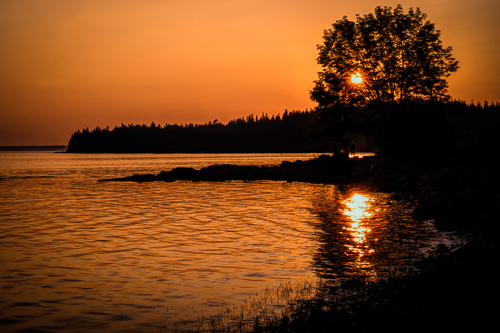10 Tips For Successful Silhouettes!
May 12, 2021 by Marie Joabar
 When faced with photographing our subject in front of a bright background, we often end up with the background perfectly exposed but our subject a silhouette.
When faced with photographing our subject in front of a bright background, we often end up with the background perfectly exposed but our subject a silhouette.
Take for example trying to photograph our friend standing on the shoreline framed against a beautiful sunset, we would most likely get a gorgeous orange sky and our friend as a black shape.
If this has happened to you and you purposely planned to capture a silhouette, then good for you, you probably don’t need to read the rest of this article.
If however, you captured a silhouette by accident and want to know how it happened so you can do it again, or perhaps NOT do it again, then read on.
Silhouettes are caused when the subject is backlit and our camera metering is set to average. When the bright sky fills the largest portion of the frame, the meter chooses to accurately expose for that causing your subject, the smaller portion of the frame, to be under exposed.
A few simple tips can help us to shoot silhouettes intentionally or avoid them when they’re not intended.
When you WANT to capture your subject as a silhouette:
 1. In using Manual mode, meter the bright area that the subject is in front of. Fill the frame with the bright part and set the exposure so the meter scale reads plus one or so (depending on how bright the area is) as a starting point. Then recompose to include your subject and take the photo. Adjust the exposure settings as needed from there.
1. In using Manual mode, meter the bright area that the subject is in front of. Fill the frame with the bright part and set the exposure so the meter scale reads plus one or so (depending on how bright the area is) as a starting point. Then recompose to include your subject and take the photo. Adjust the exposure settings as needed from there.
2. If using Aperture or Shutter Priority or Programmed Auto, meter the sky by filling the frame with the bright area. Use Exposure Lock, then recompose to include your subject keeping the exposure locked and take the photo. (Look to your camera manual for the Exposure Lock setting, some cameras have an “AE-L” button, others like Canon, have an asterisk button as the EL button.)
3. Consider using spot or center weighted metering (if you have the ability to select it). Again, fill the center or the spot area with the bright sky and set the exposure to the plus side of the meter scale (if shooting in the Manual mode), if not using Manual mode, lock the exposure and then recompose and take the photo.
4. Having strong contrast between the subject and the background will give best results. For the subject’s silhouette to be distinct, frame it fully against the bright area. Any part of the subject that’s against a darker area will not stand out.
5. Experiment with positioning, turn people sideways to capture their profile instead of face front.
6. Placing the subject directly in front of the light source will show them with rim light so they appear to glow.
7. Find subjects anywhere. Buildings and structures, lone trees, animals, people, all can work to make strong silhouette images.
8. Some of the best times to create silhouettes are around sunrise and sunset when the background is painted with dramatic shades of orange and yellow. For best results, work on captures while the sun is low in the sky and its light passes thru the atmosphere making the sky the most colorful.
9. It might be helpful to have a Neutral Density filter or a split ND filter in your bag to block some of the lights intensity, or to darken an area that is brighter than the rest.
10. If you are metering the sky with the sun in it, meter to the side of the sun, never point your camera directly at the sun or try to meter off the sun.
When you DON’T WANT your subject as a silhouette;
1. Take a meter reading off your subject’s face, (fill the frame with their face, set the exposure so the needle lines up close to zero), lock exposure and then recompose. Your bright background may be lost but your subject’s face will be exposed well.
2. Meter the brighter area, lock the exposure (if not using full Manual) and then use your flash to light your subject. It's important to consider your flash sync speed and either ensure the speed is at or below that (usually 1/200 or 1/250) or turn on high speed sync in your flash settings.
3. Move your subject so they are not positioned in front of a bright area.
Silhouettes can evoke emotion, show mood and create drama. Showing shapes with little color and no texture allows the viewer to enjoy the simplicity of a profile with no or few competing distractions. Most of all, it’s fun to do and can add another dimension to your photography. Experiment and have fun!
